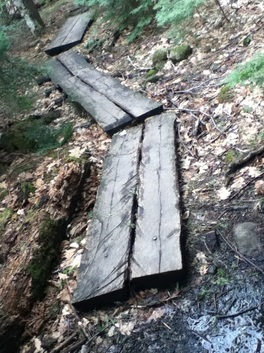
I’m ten minutes from Mount Monadnock in my mother-in-law’s 1994 Toyota Corolla and one of those mobile signage contraptions with the black letters – in New Hampshire they tend to spell out Meat Raffle or Praise the Lord – has been rolled in front of the United Church of Jaffrey. Today we learn: Life Is A Gift. Indeed, yes. I believe this. Life’s not a curse, not a things-to-do list and not simply better than the alternative. It’s a gift. My wife, Elahna, often gives me a kiss as she rises in the morning and whispers, “Every day is a gift.”
But some gifts are ugly ties and slice-o-matics, and some climbs up Monadnock aren’t worth blogging home about. April’s hike had its moments, sure, and I was glad to explore trails on the mountain’s eastern flank, but the day was mostly this: chilly, cloudy and muddy. My hat and gloves got soaked with sweat. My right knee ached, I wasted 45 minutes wandering around Gilson Pond looking for the trailhead and I saw but five sentient creatures – four humans and a shy chipmunk. Most distressingly, I didn’t feel empowered by the looming prospect and, then, the magnificent sight of the mountain peak; joy avoided my heart as I made the chilly-cloudy-muddy ascent; alas, it was a meh climb, but I got it done.
So, bear with me, this won’t take too long. And there’s some merit in field-testing the gift hypothesis, right?
I park next to a snow bank in the Gilson Pond parking lot and it starts to hail. Teeny-tiny white balls bounce off the Corolla’s hood. Winter’s cleaning out her junk drawer. I set out and stupidly march past the turnoff to the Birchtoft Trail – marked only by a huge sign – because I’m musing on the hot dog sandwiches I chowed down as a boy. You see, several split logs lay across a muddy area and, bizarrely, they remind me of the boiled dogs that I long ago sliced open, drenched in A&P catsup and shoved between white bread. Disgusting, but I liked it.
A nice moment: I watch a ruffling of white-water move across the pond’s surface – a tide of some sort, a squad of fish? No, it’s the visible manifestation of a gust of wind, and I stand and wait as the ruffling come closer, and there it is, cool upon my cheeks, and then gone.
But some gifts are ugly ties and slice-o-matics, and some climbs up Monadnock aren’t worth blogging home about. April’s hike had its moments, sure, and I was glad to explore trails on the mountain’s eastern flank, but the day was mostly this: chilly, cloudy and muddy. My hat and gloves got soaked with sweat. My right knee ached, I wasted 45 minutes wandering around Gilson Pond looking for the trailhead and I saw but five sentient creatures – four humans and a shy chipmunk. Most distressingly, I didn’t feel empowered by the looming prospect and, then, the magnificent sight of the mountain peak; joy avoided my heart as I made the chilly-cloudy-muddy ascent; alas, it was a meh climb, but I got it done.
So, bear with me, this won’t take too long. And there’s some merit in field-testing the gift hypothesis, right?
I park next to a snow bank in the Gilson Pond parking lot and it starts to hail. Teeny-tiny white balls bounce off the Corolla’s hood. Winter’s cleaning out her junk drawer. I set out and stupidly march past the turnoff to the Birchtoft Trail – marked only by a huge sign – because I’m musing on the hot dog sandwiches I chowed down as a boy. You see, several split logs lay across a muddy area and, bizarrely, they remind me of the boiled dogs that I long ago sliced open, drenched in A&P catsup and shoved between white bread. Disgusting, but I liked it.
A nice moment: I watch a ruffling of white-water move across the pond’s surface – a tide of some sort, a squad of fish? No, it’s the visible manifestation of a gust of wind, and I stand and wait as the ruffling come closer, and there it is, cool upon my cheeks, and then gone.
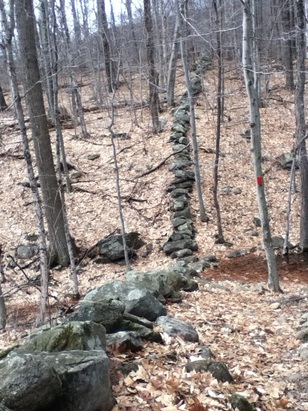
Up Birchtoft I go – birches, actually, are a minority tree in this oak and pine forest, huddled in groups of two or three, a few solo acts in corners – and the mud-creased trails get me thinking about my mother’s invocation back in the day. “Keep this up,” she’d say to her unruly children, “and your name will be mud.” Our names, it’s crucial to note, never actually became mud; her words served as a perennial threat to counter anti-social behavior. I took it to mean that a dire stain could somehow, magically, by parental or divine fiat, be visited upon my measly self, but I didn’t consider the name part much. So I do now: why ground wet dirt into my very name, as if to cover or even erase it?
LaCroix means “the cross” in French. It’s an odd name for a Jew, certainly, even for this converted one; at a conference of Jewish learning, a fellow with a knitted kippa squinted at my name tag and remarked that LaCroix was a “hell of a statement.” Of course my name is not a statement of any kind, not about my spiritual life or the Crucifixion or the constellation in the northern sky or the crossroads at the heart of every hometown, but it is a record of family behavior and movement. In fact, LaCroix was frequently acquired as a dit, or alias, by Europeans on the lam from the law or various persecutions. So my real name on my father’s side may have become mud out of necessity or desperation. LaCroix could be a cover story. There’s something very Jewish about that, I think.
About a mile up, the trees begin to bloom snow. The trunks and branches are snow dusted only on their sides facing east, away from the summit. Wind patterns, the sun’s track? I sit and drink water and chat on the phone with my daughter Kelsey in Pittsburgh. We’d had an argument a week ago – a rare occurrence; I strive to keep conversations with my out-of-state daughter productive, upbeat – and it’s good now to talk casually, to reassure each other that all is okay. Then the sun, hello, peeks out and within minutes clumps of snow begin to fall from the high boughs. Bam, boom, smash! Melty mush crashes to earth. Delicate snowflakes that descended in February now coalesce and take an April suicide dive. Bam, boom, smash! The forest sheds the last shreds of winter.
Soon I’m walking again, and beside me a stone wall undulates into a ravine and back up the other side. A stone snake, very cool. It’s thickly built, collapsing – is there a subterranean wall, a mirror image, sunk into the earth? It probably stood three or four feet high in sheep-farming days. The forest is sparsely wooded here, branches as bare as trunks, the ground tree-to-tree carpeted with crunchy, light-brown leaves that emit a nutty aroma as I churn through. Abruptly the wall ends, as if the farmer got tired lugging rocks and went home, and the way devolves into a muddy stream. I pick along the sides of the trail but can’t prevent my left foot from getting soaked to the sock, skin and bone.
LaCroix means “the cross” in French. It’s an odd name for a Jew, certainly, even for this converted one; at a conference of Jewish learning, a fellow with a knitted kippa squinted at my name tag and remarked that LaCroix was a “hell of a statement.” Of course my name is not a statement of any kind, not about my spiritual life or the Crucifixion or the constellation in the northern sky or the crossroads at the heart of every hometown, but it is a record of family behavior and movement. In fact, LaCroix was frequently acquired as a dit, or alias, by Europeans on the lam from the law or various persecutions. So my real name on my father’s side may have become mud out of necessity or desperation. LaCroix could be a cover story. There’s something very Jewish about that, I think.
About a mile up, the trees begin to bloom snow. The trunks and branches are snow dusted only on their sides facing east, away from the summit. Wind patterns, the sun’s track? I sit and drink water and chat on the phone with my daughter Kelsey in Pittsburgh. We’d had an argument a week ago – a rare occurrence; I strive to keep conversations with my out-of-state daughter productive, upbeat – and it’s good now to talk casually, to reassure each other that all is okay. Then the sun, hello, peeks out and within minutes clumps of snow begin to fall from the high boughs. Bam, boom, smash! Melty mush crashes to earth. Delicate snowflakes that descended in February now coalesce and take an April suicide dive. Bam, boom, smash! The forest sheds the last shreds of winter.
Soon I’m walking again, and beside me a stone wall undulates into a ravine and back up the other side. A stone snake, very cool. It’s thickly built, collapsing – is there a subterranean wall, a mirror image, sunk into the earth? It probably stood three or four feet high in sheep-farming days. The forest is sparsely wooded here, branches as bare as trunks, the ground tree-to-tree carpeted with crunchy, light-brown leaves that emit a nutty aroma as I churn through. Abruptly the wall ends, as if the farmer got tired lugging rocks and went home, and the way devolves into a muddy stream. I pick along the sides of the trail but can’t prevent my left foot from getting soaked to the sock, skin and bone.
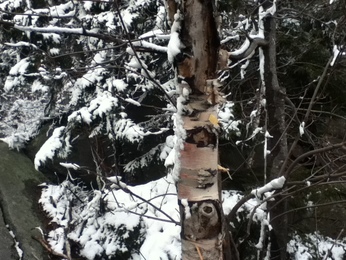
I stop, look up: no vista, nothing but woods ascending. Not once on this dank day have I seen Monadnock’s spire. Indeed this is a furtive approach to my old friend, without fanfare or visible incentive. I’m the annoying neighbor dropping in by the side yard.
Crossing the Cascade Link Trail, which runs north-south, I continue to the summit on the Red Spot Trail – marked, you guessed it, by white-encircled red spots on boulders. Thirty yards up a cliff wall, a small waterfall churns, shush, shush, and just a few feet to the right clings a huge burl of ice existing outside, I suppose, the arc of the sun. Poetess Amy Lowell understood this kind of juxtaposition: Thou standest, bright with April's buoyancy, she wrote in “Monadnock in Early Spring” (1912). Yet holding Winter in some shaded wall /Of stern, steep rock…
Nothing blooms yet. Curled-up oak leaves, paper-thin, stubbornly cling to branches. I scan for the Doric Temple, a rock formation that’s said to resemble a Greek temple – nope, not here, not today. Maybe it’s a figment of a professor’s imagination, a hiker’s trick. There is, however, a cavern between boulders that looks just right for a bear den. The opening is triangular, like a rock tepee, and half shrouded by tree limbs. Should I creep closer? Maybe take a peak, toss in a pine cone? Nope, not today, not feeling adventurous.
My head brushes a pine bough and a pint of slushy snow ripples down my neck, between coat and t-shirt. Instantly, I remember my older brother Chris harassing me at the bus stop at the top of Wendy Lane, 45 years ago. He lured me beneath a snow-burdened bough, stepped aside and shook the branch. I yelped; he cackled. Hilarious. If my mother had witnessed the scene, she might have intoned: keep that up, mister, and your name is mud. And Chris would have smirked.
Above the tree line, I cross onto the Pumpelly Trail and, finally, see the peak. Monadnock is a gray, unforgiving lady today: gray rocks on gray sky. Streaks of stubborn snow. I’ve climbed in hopes for spring on the mountain – just a flower or two, a baby robin here, a fiddlehead uncurling there – but my impatience has been exposed. Monadnock shrugs, doesn’t care. As Lowell wrote: Another year is quick with import. Such each year has been. Unmoved thou watchest all. Dutifully, I pick up the pace, high-stepping across boulders dabbed with lime-green lichen the size of thumbprints, and I make it to the top and tap my hiking pole on the Geodetic Survey plaque. A freezing-cold wind bites me back. Ah, well. And there I meet my first fellow travelers, huddled against the cold.
Crossing the Cascade Link Trail, which runs north-south, I continue to the summit on the Red Spot Trail – marked, you guessed it, by white-encircled red spots on boulders. Thirty yards up a cliff wall, a small waterfall churns, shush, shush, and just a few feet to the right clings a huge burl of ice existing outside, I suppose, the arc of the sun. Poetess Amy Lowell understood this kind of juxtaposition: Thou standest, bright with April's buoyancy, she wrote in “Monadnock in Early Spring” (1912). Yet holding Winter in some shaded wall /Of stern, steep rock…
Nothing blooms yet. Curled-up oak leaves, paper-thin, stubbornly cling to branches. I scan for the Doric Temple, a rock formation that’s said to resemble a Greek temple – nope, not here, not today. Maybe it’s a figment of a professor’s imagination, a hiker’s trick. There is, however, a cavern between boulders that looks just right for a bear den. The opening is triangular, like a rock tepee, and half shrouded by tree limbs. Should I creep closer? Maybe take a peak, toss in a pine cone? Nope, not today, not feeling adventurous.
My head brushes a pine bough and a pint of slushy snow ripples down my neck, between coat and t-shirt. Instantly, I remember my older brother Chris harassing me at the bus stop at the top of Wendy Lane, 45 years ago. He lured me beneath a snow-burdened bough, stepped aside and shook the branch. I yelped; he cackled. Hilarious. If my mother had witnessed the scene, she might have intoned: keep that up, mister, and your name is mud. And Chris would have smirked.
Above the tree line, I cross onto the Pumpelly Trail and, finally, see the peak. Monadnock is a gray, unforgiving lady today: gray rocks on gray sky. Streaks of stubborn snow. I’ve climbed in hopes for spring on the mountain – just a flower or two, a baby robin here, a fiddlehead uncurling there – but my impatience has been exposed. Monadnock shrugs, doesn’t care. As Lowell wrote: Another year is quick with import. Such each year has been. Unmoved thou watchest all. Dutifully, I pick up the pace, high-stepping across boulders dabbed with lime-green lichen the size of thumbprints, and I make it to the top and tap my hiking pole on the Geodetic Survey plaque. A freezing-cold wind bites me back. Ah, well. And there I meet my first fellow travelers, huddled against the cold.
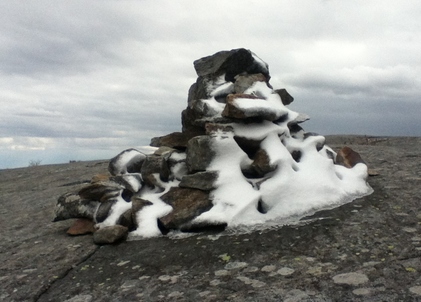
They sit, hip to hip, shivering. He’s fourteen, she’s a bit younger maybe. He wears a backwards ball cap and she sports white earmuffs from an attic trunk. Light coats, sneakers, no gloves. She sips from a straw in a plastic thingy, he shovels chips from a crinkly bag. I greet them and mention the absence of gloves. Their response: hey, it’s springtime. Who knew? They smile all silly-like. Surely this is one of those crazy couple stories they’ll curate as long as they’re together. (Fifth period, next Monday?)
I stand apart. A swatch of trees at the mountain’s base betrays a deep, crimson cast, as if blood has come to the surface. As if winter’s bruise has emerged. To the west, beyond dark pine groves, a funnel cloud dumps slushy, white stuff. The cloud appears frayed, disintegrating, although some fractal architecture, some purposeful geometry undergirds it all – and more to the point it’s moving toward me, up the mountainside. On most days I’d smile and set my feet and arch my back and let the weather roll past, let it scrub my troubles free. I’d embrace every little adventure coming my way.
But not today – today I spurn the offering. I turn and go back down.
Near the tree line, I’m hailed by a middle-aged man with a German accent. He’s standing on a stack of granite about 25 yards away. “How do we get to the summit?” he calls. It’s kind of amusing, actually, since the peak is right there in full view, towering over us. Going from A to B, though, is rarely a straight-ahead business – in mountain climbing and life – and I point out a route around a gully jammed with dormant shrubbery. Then curl back from the north on the Pumpelly Trail, I say, and you’re there. “Thank you,” hollers the German, as if I’d done something wonderful, and now a younger man – his son? – appears. “How long?” he asks. No accent marks him. Hmm, should I lie? “Ten minutes,” I say. Then: “Well, maybe fifteen.”
I stand apart. A swatch of trees at the mountain’s base betrays a deep, crimson cast, as if blood has come to the surface. As if winter’s bruise has emerged. To the west, beyond dark pine groves, a funnel cloud dumps slushy, white stuff. The cloud appears frayed, disintegrating, although some fractal architecture, some purposeful geometry undergirds it all – and more to the point it’s moving toward me, up the mountainside. On most days I’d smile and set my feet and arch my back and let the weather roll past, let it scrub my troubles free. I’d embrace every little adventure coming my way.
But not today – today I spurn the offering. I turn and go back down.
Near the tree line, I’m hailed by a middle-aged man with a German accent. He’s standing on a stack of granite about 25 yards away. “How do we get to the summit?” he calls. It’s kind of amusing, actually, since the peak is right there in full view, towering over us. Going from A to B, though, is rarely a straight-ahead business – in mountain climbing and life – and I point out a route around a gully jammed with dormant shrubbery. Then curl back from the north on the Pumpelly Trail, I say, and you’re there. “Thank you,” hollers the German, as if I’d done something wonderful, and now a younger man – his son? – appears. “How long?” he asks. No accent marks him. Hmm, should I lie? “Ten minutes,” I say. Then: “Well, maybe fifteen.”
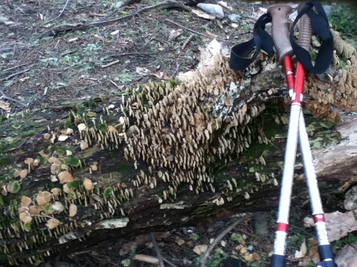
And I clamber down Monadnock, mucking through mud and slipping and catching myself on bendy saplings. The knee still aches. That chipmunk I mentioned pops up, dashes away. Maybe he doesn’t like my attitude; maybe he’s having a droopy day, too. The sun condescends to say hello again, catalyzing another round of winter shedding. Bam, boom, smash! Snowy bombs away! It’s Kurt Vonnegut’s season of unlocking in action. The author, whose books I gobbled like potato chips as a teen, believed that the four-season model was a poor fit for northern climes, leading to ritualistic disappointment and depression. For instance, spring as we understand it rarely arrives in March. In a commencement address at Fredonia State University of New York, he proposed a six-season superstructure: Winter (January-February), Unlocking (March-April), Spring (May-June), Summer (July-August), Autumn (September-October) and Locking (November-December).
Vonnegut’s six-season corrective, second in brilliance to his accidental annihilator Ice-nine in Cat’s Cradle, has little chance of being adopted by our gridlocked Congress. But it would encourage more realistic attitudes. For instance, if this was the season of Unlocking, I mightn’t have come to the mountain wishing for blue birds and pink blooms, and I mightn’t have fallen into funkdom upon finding only brown-ribbed fungus on a rotting log.
I make it down. The car’s there, alone in the lot, and it starts up. The sky fails to dump more hail shavings as I change from soaked boots to sneaks. Hooray! These are all good things. Occasions, even, for gratitude. My desultory day on Monadnock, however, leaks into the next. I awake with a sore right hand, swollen from knuckles to wrist. It hurts to extend my fingers. And the thing is, I don’t remember smashing my hand – wouldn’t my brain have registered the pain? Perhaps I whacked it on a tree trunk or boulder during an inglorious, distracting wipeout. And now, ten days later, it’s not much better. I can barely type – poor, poor me. Has one of the 27 hand bones, let’s say the third metacarpal, broken?
Or maybe I’m unlocking, just like the mountain, like the world, and in the slow, agonizing progress from winter to spring a few bits and pieces are bound to go gonzo at my age. It’ll heal, soon enough. I’ll be back up in real spring – blue birds and pink blooms prepare! Get ready to see who’s more alive and kicking.
Every day is a gift.
Vonnegut’s six-season corrective, second in brilliance to his accidental annihilator Ice-nine in Cat’s Cradle, has little chance of being adopted by our gridlocked Congress. But it would encourage more realistic attitudes. For instance, if this was the season of Unlocking, I mightn’t have come to the mountain wishing for blue birds and pink blooms, and I mightn’t have fallen into funkdom upon finding only brown-ribbed fungus on a rotting log.
I make it down. The car’s there, alone in the lot, and it starts up. The sky fails to dump more hail shavings as I change from soaked boots to sneaks. Hooray! These are all good things. Occasions, even, for gratitude. My desultory day on Monadnock, however, leaks into the next. I awake with a sore right hand, swollen from knuckles to wrist. It hurts to extend my fingers. And the thing is, I don’t remember smashing my hand – wouldn’t my brain have registered the pain? Perhaps I whacked it on a tree trunk or boulder during an inglorious, distracting wipeout. And now, ten days later, it’s not much better. I can barely type – poor, poor me. Has one of the 27 hand bones, let’s say the third metacarpal, broken?
Or maybe I’m unlocking, just like the mountain, like the world, and in the slow, agonizing progress from winter to spring a few bits and pieces are bound to go gonzo at my age. It’ll heal, soon enough. I’ll be back up in real spring – blue birds and pink blooms prepare! Get ready to see who’s more alive and kicking.
Every day is a gift.
 RSS Feed
RSS Feed